We are often asked by users about what to do right after starting a blog.
Once you have installed WordPress, there are still quite a few things you need to do to properly set up and launch your website.
In this article, we will share the most important things that you will immediately want to do after installing WordPress.

After setting up a WordPress blog, there are essential WordPress settings you should ensure are enabled on your website.
We’ve put together a list of settings. You can click the links below to go to your preferred section:
- Add a Contact Form
- Change Site Title, Tagline, and Timezone
- Setup WordPress SEO
- Install Google Analytics
- Install Caching
- Setup Backups
- Setup WordPress Security
- Setup Spam Protection
- Delete Unused WordPress Themes
- Setup WordPress Comments
- Delete Default Content
- Setup a Default Category
- Setup Front and Blog Pages
- Upload Your Gravatar
- Complete Your User Profile
- Upload Favicon and Site Icon
- Change WordPress Email Address
- Setup Your WordPress Theme
1. Add a Contact Form
All websites on the internet need a contact form. It allows your website visitors to contact you quickly by simply filling out a form on your website.
You can get feedback from users and help resolve their queries. By default, WordPress does not come with a built-in contact form.
This is where WPForms comes in. It is the best WordPress contact form plugin that allows you to easily create beautiful contact forms for your website.
It also has a WPForms free version that you can download from the WordPress.org plugin repository.
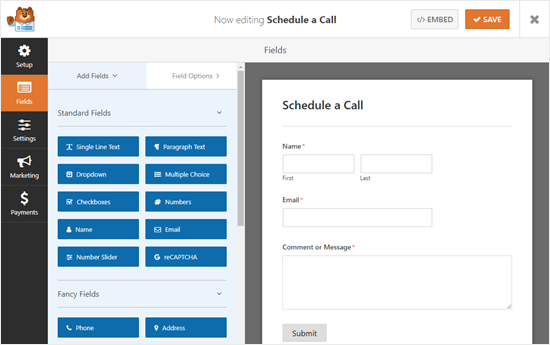
See our step-by-step guide on how to create a contact form in WordPress.
2. Change Site Title, Tagline, and Timezone
Next, you need to change the site title, tagline, and timezone settings.
Simply head over to the Settings » General page and change these settings.
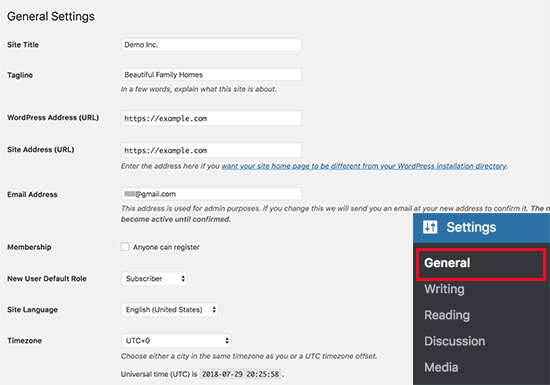
3. Set Up WordPress SEO
SEO, short for Search Engine Optimization, is used by website owners to get more traffic from Google and other search engines.
WordPress is pretty SEO-friendly out of the box. However, there is a lot more that you can do to optimize your SEO and get more traffic to your website.
The best time to set up your website’s SEO is right after installing WordPress.
We recommend using the All in One SEO plugin. It is the most comprehensive WordPress SEO plugin on the market, and it takes care of all the important SEO settings out of the box.
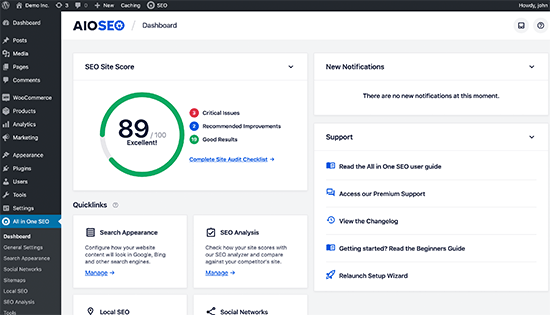
For complete step-by-step instructions, see our ultimate WordPress SEO guide for beginners.
4. Install Google Analytics
As a website owner, you need to understand your audience, what they are looking for, and how you can help them find it. These insights help you make smarter decisions to grow your business.
This is where you need Google Analytics. It shows you how many people visit your website, where they came from, and what they did on your website.
The easiest way to install Google Analytics is by using MonsterInsights. It is the best Google Analytics plugin for WordPress and shows beautiful analytics reports right inside WordPress.
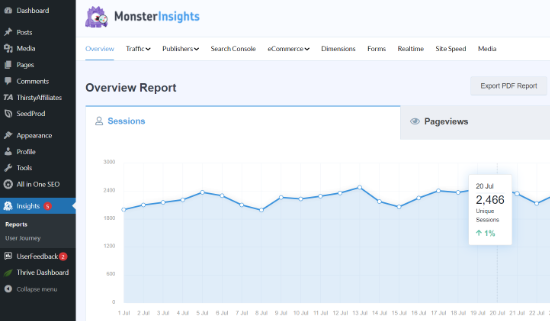
For the complete setup, see our beginner’s guide on how to easily install Google Analytics in WordPress.
5. Install a Caching Plugin
Studies show that 1 second delay in page load time can lead to a 7% loss in conversions, 11% fewer page views, and a 16% decrease in customer satisfaction.
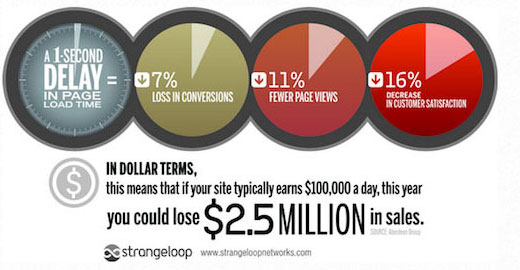
As a website owner, you need to make sure that your website is fast and performs well even under high traffic.
This is where caching comes in. It allows your website to quickly serve cached copies of your pages to users instead of generating them on the fly. This reduces server load on your website and improves your page load speed.
There are a lot of caching plugins available for WordPress, but we recommend using the WP Rocket plugin.
See our guide on how to install and set up the WP Rocket plugin for detailed instructions.
Caching alone can significantly improve your website’s speed. However, there are lots of other things you can do to make it faster. See our complete guide on how to improve WordPress speed & performance.
6. Setup Backups
Each year, millions of dollars worth of damages are caused by data loss. Creating backups is the only way to make sure that you can easily recover your website in case of a disaster.
Some WordPress hosting companies offer limited backup services with their hosting plans. However, these backups are not guaranteed, and it is your responsibility to back up your website on your own.
Luckily, there are several great WordPress backup plugins that you can use to create backups automatically.
We recommend using Duplicator Pro. It is the best WordPress backup plugin and allows you to set up automatic backup schedules. You can also store your backups securely on remote cloud storage services like Google Drive, Amazon S3, Dropbox, and more.
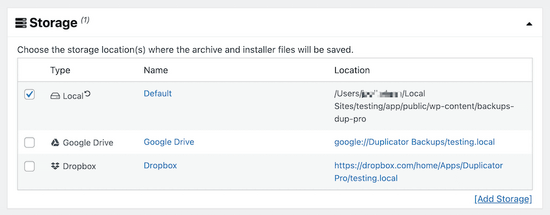
There’s also a free version of Duplicator that allows you to create manual backups.
For step-by-step instructions, see our tutorial on how to back up your WordPress site.
7. Setup WordPress Security
WordPress is quite secure out of the box. However, you still need to follow security best practices to keep your website secure.
Some of these best practices are quite easy to do on your own like using strong passwords, securing the WordPress admin area, and installing updates.
For other things, you will need a plugin. There are some great WordPress security plugins that you can use.
We recommend using Sucuri. They are the industry leader in website security, vulnerability scanning, and malware protection.
The best part about using Sucuri is that it offers the best WordPress firewall plugin. A website firewall blocks suspicious traffic from ever reaching your website.

For complete instructions, follow the steps in our ultimate WordPress security guide for beginners.
8. Setup Spam Protection
Spam comments can be quite problematic. Most of them contain links to malicious websites known for distributing malware. Spam comments can affect your search rankings and your website’s reputation.
You can enable comment moderation in WordPress to prevent any comment from appearing without approval. However, as the quantity of spam grows, you will be spending considerable time moderating comments.
To fix this, you need to install and activate the Akismet plugin. It is a WordPress anti-spam plugin and one of the only two plugins that come pre-installed on every WordPress website.

To learn more, see our guide on how to set up the Akismet anti-spam plugin in WordPress.
9. Delete Unused WordPress Themes
Most WordPress users will install and test a few WordPress themes before deciding on one that’s a keeper. Instead of leaving those unused themes installed, be sure to delete them. The reason for that is that even inactive themes will need updates.
We do recommend keeping at least one default theme installed. This theme will act as a fallback in case you have to switch themes when troubleshooting errors.
Simply go to the Appearance » Themes page and click on an unused theme that you want to delete. This will bring up a popup showing theme details. In the bottom-right corner of the popup, you will see the link to delete the theme.
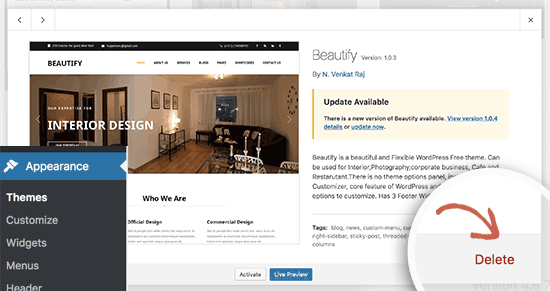
Repeat the process to delete all unused themes.
10. Setup WordPress Comments
Comments play an important role in most blogs. They are a good indicator of user engagement and allow you to build a community around your blog.
Simply go to Settings » Discussion page to set up comments. From here, you can enable or disable comments, configure comment notifications, and enable comment moderation.
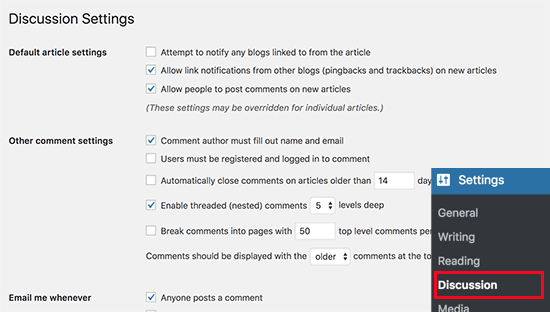
See our post on the best plugins to improve WordPress comments for more tips.
11. Delete Default Content
WordPress comes with some default content to be used as placeholder items. This includes a blog post titled ‘Hello World’, a sample comment, and a sample page.
Simply go to the Posts » All Posts page. Take your mouse to the ‘Hello World’ post and then click on the ‘Trash’ link.
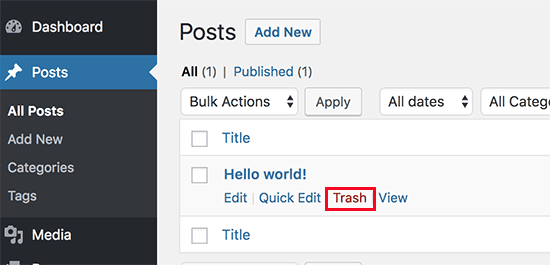
Next, go to Pages » All Pages page and then delete Sample Page.
Lastly, visit the Comments page and then delete the default comment.
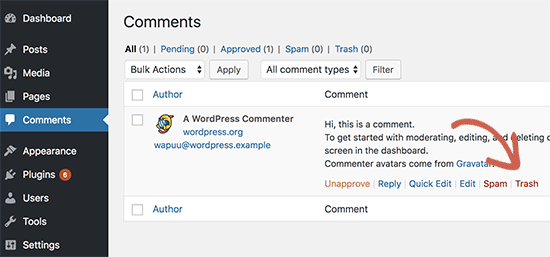
12. Set Up a Default Category
WordPress posts are required to be filed under at least one category. By default, WordPress uses the ‘Uncategorized’ category as the default category.
If you don’t change the category when writing a blog post, then it will automatically be filed under the default category.
To change the default category, first, you need to visit the Posts » Categories page to create a new category. This will be used as your new default category.

After that, go to Settings » Writing page.
Here, you will see the default category option. You can go ahead and select the new category you created earlier.
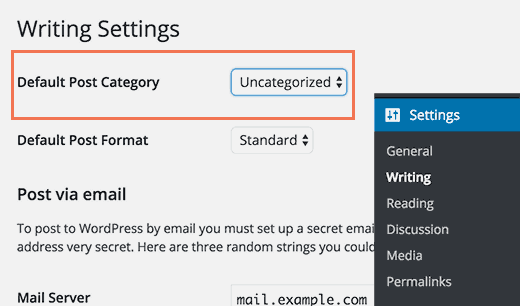
Finally, you can go to the Posts » Categories page and delete the ‘Uncategorized’ category.
To learn more, see our guide on how to change the default Uncategorized category in WordPress.
13. Setup Front and Blog Pages
By default, WordPress displays your blog posts on the homepage. However, if you are making a small business website, then you will want to use a static page as your homepage.
Even most blogs want to use a static front page as their homepage. This allows them to create custom layouts for their homepage.
To set up these pages, you can simply go to Settings » Reading from your WordPress dashboard and select the pages you want to use as your front page and blog page.
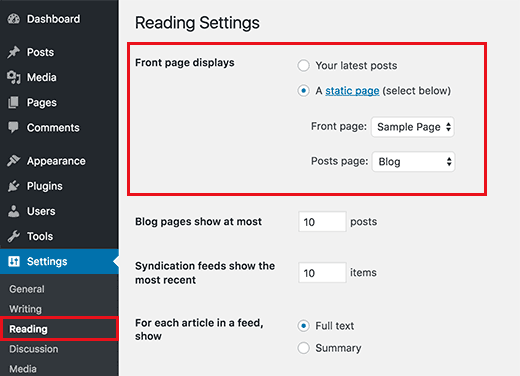
For more details, see our article on how to add a separate page for blog posts in WordPress.
14. Upload Your Gravatar
WordPress uses Gravatar to display user photos in author bios and in WordPress comments.
Gravatar is a profile image hosting service that allows users to use the same photo as their profile image across millions of websites.

Simply go to Gravatar’s website and create an account using the email address you have used in your WordPress account.
After that, you can use this email address to comment on millions of websites using Gravatar, including your own site.
For more details, see our article on how to use Gravatar in WordPress.
15. Complete Your User Profile
Next, you would want to complete your WordPress user profile.
Simply head over to Users » Your Profile from your WordPress admin panel to update your profile information.
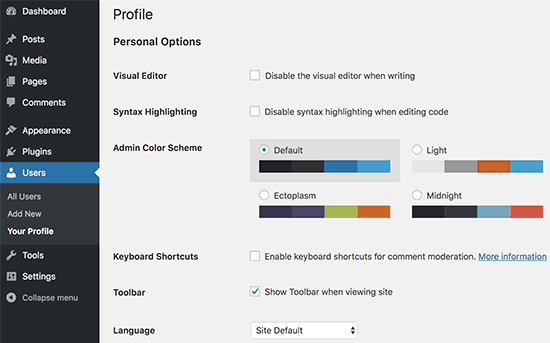
By default, WordPress will use your username next to your blog posts and comments. You would want to replace it with your full name or nickname. See our article on how to add or change your full name in WordPress.
You would also want to provide your website link. Other WordPress plugins may also add their own custom fields to your user profile like social media links.
Lastly, enter a short bio of yourself. This would give your users a quick introduction and help them learn more about the author behind the articles.
16. Upload Favicon and Site Icon
A Favicon or Site Icon is the tiny image that appears next to your website title in the browser.
It helps your users identify your website and increases brand recognition among your most frequent visitors.

First, you will need to create an image of exactly 512×512 pixels in dimensions and save it in PNG, JPEG, or GIF format.
After that, you need to visit Appearance » Customize and click on the ‘Site Identity’ tab. Under the ‘Site Icon’ section click on the ‘Select File’ button to upload your favicon.
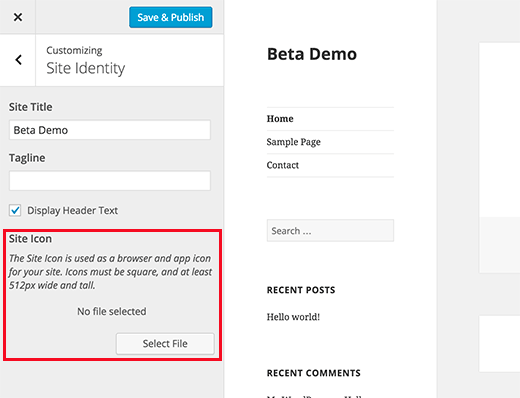
For more details, see our article on how to add a favicon and site icon in WordPress for step-by-step instructions.
17. Change the WordPress Email Address
Most users add their own email addresses when installing WordPress. This means their first user profile and their website’s email address are the same.
To change this, you can go to the Settings » General page and enter the new email address you would like to use for the website.

Make sure that the new email address is active, as WordPress will send a confirmation email to that address.
You can use any email address here. However, it would be best to use an email address that shows that this address is for automated emails sent from your website.
If you want to use email accounts using your own domain name, then please see our guide on how to create a free business email address for your WordPress website.
18. Set Up Your WordPress Theme
The next step is to set up your WordPress theme. Most WordPress themes come with different features and customization options.
However, there are some basic settings that are the same in all WordPress themes. In fact, they are common among most websites on the planet.
Let’s start with setting up navigation menus. It is the links menu that usually appears in the header section. It contains links to different areas of your website.

For detailed instructions, see our beginner’s guide on setting up navigation menus in WordPress.
Next, you would want to add widgets to your WordPress. Widgets allow you to add different blocks to your website’s sidebar or widget-ready areas.
By default, WordPress will display a few default widgets in your primary sidebar. You would want to rearrange them or add other widgets. Your theme may also come with its own custom widgets for social media and other features that you would want to use.
For detailed instructions, see our beginner’s guide on how to add and use widgets in WordPress.
Your theme may also include plenty of other options like color schemes, layout choices, header styles, and more. Explore these options and set them up to your own liking.
We hope this article helped you learn things you will immediately want to do after installing WordPress. You may also want to see the best email marketing services and how to start a podcast and make it successful.
If you liked this article, then please subscribe to our YouTube Channel for WordPress video tutorials. You can also find us on Twitter and Facebook.





Syed Balkhi says
Hey WPBeginner readers,
Did you know you can win exciting prizes by commenting on WPBeginner?
Every month, our top blog commenters will win HUGE rewards, including premium WordPress plugin licenses and cash prizes.
You can get more details about the contest from here.
Start sharing your thoughts below to stand a chance to win!
Mrteesurez says
I appreciate this guide. If I could have seen this post when I was started, it would have been better to setup all necessary things before going live. Analytics is the most important to track usage of website, I installed it lately so I lose some early traffics report. Thanks for your guidance. All beginner bloggers need to read this.
Kabsha Majid says
You have put a lot of effort into this guide. Very simple and easy-to-understand content. I learned new things from it. Thank you!
WPBeginner Support says
You’re welcome, glad our recommendations were helpful!
Admin
Shiv K Mittal says
Thank you for all the useful details.Really simple and great way to explain.
WPBeginner Support says
Glad you found our guide helpful
Admin
Emmanuel Amadi says
Should I delete the blogger importer and Blogger to WordPress plugins after the migrations from blogger to WordPress entire process. I am looking for ways to make my WordPress Dashboard load faster
WPBeginner Support says
For speeding up your site, we would recommend taking a look at our article below:
https://www.wpbeginner.com/wordpress-performance-speed/
Those two plugins shouldn’t affect your dashboard’s speed. If you remove the Blogger to WordPress plugin it can break redirects but you can delete the Blogger importer if you wanted.
Admin
Adrian says
I would add that you should also ensure that your host has blocked directory access to your uploads folder by default! I only found out after someone told me that all of the profile pictures of our private clients could be seen by anyone looking at the oursite.com/wp-content/uploads folder.
WPBeginner Support says
While not all sites need that feature, you can manually add that using the method in our guide below:
https://www.wpbeginner.com/wp-tutorials/disable-directory-browsing-wordpress/
Admin
Rahul says
This article made my blog better..thank you …
WPBeginner Support says
You’re welcome
Admin
Alok Sharma says
This is the great guide for a beginner!
Thank you so much!
WPBeginner Support says
You’re welcome
Admin
Michelle Cooke says
Are these plug-ins free? I am looking to make the switch from WordPress.com to .org. I have the business plan over at .com and I am trying to see if switching will actually cost more in the end. Like outside of hosting, what are the other fees I need to account for?
WPBeginner Support says
It would depend on the type of site for how much cost, you would want to take a look at our article below for more:
https://www.wpbeginner.com/beginners-guide/how-much-does-it-cost-to-build-a-wordpress-website/
Admin
Vidhya says
Thank you. I am a newbee here who knows nothing about running website. This blog made by day’s learning.
WPBeginner Support says
Glad you found our guides helpful
Admin
Bren Haas says
Thank you so much for all the work you put into your blog. I refer to your wordpress help often and share with others.
Thank you! Bren
WPBeginner Support says
You’re welcome, glad you’ve found our guides helpful
Admin
dinesh dhamala says
really helpful . i learnt many things from this post . thanks for providing such useful content.
WPBeginner Support says
You’re welcome, glad our guide was helpful
Admin
Beginner says
Can I sign up with a hosting provider after doing all these things?
In other words, at the same time as signing up with a hosting provider, is it possible to publish a site by exporting an existing WordPress to the provider instead of installing a new WordPress?
WPBeginner Support says
You can do that by creating a local site and then transfer it to a host using the method in our article here: https://www.wpbeginner.com/wp-tutorials/how-to-move-wordpress-from-local-server-to-live-site/
Admin
Deborah says
Thank you for all the best in-depth articles for new WordPress users. I was going to ask how to put the little icon next to my website name, and found the answer in this article. THANKS!
Ban sharma says
thanks for this post. i have a question when we use static front page .so it’s compulsry to select a blog page.becoz i don’t have a particular blog page ..so what i select
Naureen says
No, it is not compulsory.
Njofie Wilson says
You can use a plugin called “Post Grid” to display blog posts on any page of your website that you want, using a shortcode. Just install the plugin and play around with to your taste.
Monica says
Thank you for your generosity with those who just started. Very useful!!!!